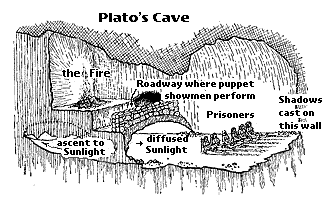I feel put into contemporary context the allegory of the cave teaches us to explore possibilities beyond the fire and beyond the cave. We are taught science at school, religion in church and only ever given these few varying options of belief in what is real, how we came to be and our destiny as beings on earth. We very rarely look beyond these teachings and believe in anything other than the things we can see in plain sight and the stories we are told as children to be truth.
Plato's cave tells us that we know nothing; we see what we see. But if one man were to see beyond what the rest of us see and claim to that we would likely call him crazy, lock him up and kill his ideas about the world. The philosophy is that we should believe in much more than what we can simply see before us.
I found a simple translation of the text - put into much simpler bullet pointed parts to explore this text in more detail.
- Plato realizes that the general run of humankind can think, and speak, etc., without (so far as they acknowledge) any awareness of his realm of Forms.
- The allegory of the cave is supposed to explain this.
- In the allegory, Plato likens people untutored in the Theory of Forms to prisoners chained in a cave, unable to turn their heads. All they can see is the wall of the cave. Behind them burns a fire. Between the fire and the prisoners there is a parapet, along which puppeteers can walk. The puppeteers, who are behind the prisoners, hold up puppets that cast shadows on the wall of the cave. The prisoners are unable to see these puppets, the real objects, that pass behind them. What the prisoners see and hear are shadows and echoes cast by objects that they do not see. Here is an illustration of Plato’s Cave:

From Great Dialogues of Plato (Warmington and Rouse, eds.) New York, Signet Classics: 1999. p. 316. - Such prisoners would mistake appearance for reality. They would think the things they see on the wall (the shadows) were real; they would know nothing of the real causes of the shadows.
- So when the prisoners talk, what are they talking about? If an object (a book, let us say) is carried past behind them, and it casts a shadow on the wall, and a prisoner says “I see a book,” what is he talking about?He thinks he is talking about a book, but he is really talking about a shadow. But he uses the word “book.” What does that refer to?
- Plato gives his answer at line (515b2). The text here has puzzled many editors, and it has been frequently emended. The translation in Grube/Reeve gets the point correctly:
“And if they could talk to one another, don’t you think they’d suppose that the names they used applied to the things they see passing before them?”
- Plato’s point is that the prisoners would be mistaken. For they would be taking the terms in their language to refer to the shadows that pass before their eyes, rather than (as is correct, in Plato’s view) to the real things that cast the shadows.If a prisoner says “That’s a book” he thinks that the word “book” refers to the very thing he is looking at. But he would be wrong. He’s only looking at a shadow. The real referent of the word “book” he cannot see. To see it, he would have to turn his head around.
- Plato’s point: the general terms of our language are not “names” of the physical objects that we can see. They are actually names of things that we cannot see, things that we can only grasp with the mind.
- When the prisoners are released, they can turn their heads and see the real objects. Then they realize their error. What can we do that is analogous to turning our heads and seeing the causes of the shadows? We can come to grasp the Forms with our minds.
- Plato’s aim in the Republic is to describe what is necessary for us to achieve this reflective understanding. But even without it, it remains true that our very ability to think and to speak depends on the Forms. For the terms of the language we use get their meaning by “naming” the Forms that the objects we perceive participate in.
- The prisoners may learn what a book is by their experience with shadows of books. But they would be mistaken if they thought that the word “book” refers to something that any of them has ever seen.Likewise, we may acquire concepts by our perceptual experience of physical objects. But we would be mistaken if we thought that the concepts that we grasp were on the same level as the things we perceive.
Upon reading this description I felt even that is still academically challenging to people who may not have any previous knowledge and understanding of philosophy. It needed to be simplified and translated into a way that anyone could understand.
TARGET AUDIENCE - I decided the best time to learn about this kind of philosophy would be when your young and in need of inspiration. So my target audience has become a younger audience 16-26, old enough to have a basic understanding but not likely to of come across this content before unless they have specifically studied it.
No comments:
Post a Comment